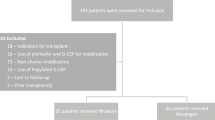Abstract
Autologous peripheral blood stem cell (PBSC) transplantation results in rapid hematologic recovery when sufficient numbers of CD34+ cells/kg are infused. Recent studies suggest that filgrastim (G-CSF) administration following transplantation leads to more rapid neutrophil recovery and lower total transplant costs. This study compares the use of G-CSF (5 μg/kg/day) with sargramostim (GM-CSF) 500 μg/day from day 0 until neutrophil recovery (ANC >1500/mm3) in patients with breast cancer or myeloma who had PBSC mobilized with the combination of cyclophosphamide, etoposide, and G-CSF. Twenty patients (13 breast cancer and seven myeloma) received GM-CSF and 26 patients (14 breast cancer and 12 myeloma) received G-CSF. The patients were comparable for age and stage of disease, and received stem cell grafts that were not significantly different (CD34+×106/kg was 12.5 ± 11.1 (mean ± s.d.) for GM-CSF and 19.8 ± 18.5 for G-CSF; P = 0.10). The use of red cells (2.8 vs 2.3 units), and platelet transfusions (2.5 vs 3.1) was similar for the two groups, as was the use of intravenous antibiotics (4.3 vs 4.6 days) and the number of days with temperature >38.3°C (2.3 vs 1.8). Platelet recovery was also similar in both groups (platelets >50 000/mm3 reached after 11.8 vs 14.9 days). The recovery of neutrophils, however, was faster using G-CSF. ANC >500/mm3 and >1000/mm3 were reached in the GM-CSF group at 10.5 ± 1.5 and 11.0 ± 1.7 days, respectively, whereas with G-CSF only 8.8 ± 1.2 and 8.9 ± 2.2 days were required (P < 0.001). as a result, patients given g-csf received fewer injections than the gm-csf patients (10.9 vs 12.3). Resource utilization immediately attributable to the use of growth factors and the duration of pancytopenia, excluding hospitalization, were similar for the two groups. This study suggests that neutrophil recovery occurs more quickly following autologous PBSC transplant using G-CSF in comparison to GM-CSF, but the difference is not extensive enough to result in lower total cost.
This is a preview of subscription content, access via your institution
Access options
Subscribe to this journal
Receive 12 print issues and online access
$259.00 per year
only $21.58 per issue
Buy this article
- Purchase on Springer Link
- Instant access to full article PDF
Prices may be subject to local taxes which are calculated during checkout
Similar content being viewed by others
Author information
Authors and Affiliations
Rights and permissions
About this article
Cite this article
Jansen, J., Thompson, E., Hanks, S. et al. Hematopoietic growth factor after autologous peripheral blood transplantation: comparison of G-CSF and GM-CSF. Bone Marrow Transplant 23, 1251–1256 (1999). https://doi.org/10.1038/sj.bmt.1701806
Received:
Accepted:
Published:
Issue Date:
DOI: https://doi.org/10.1038/sj.bmt.1701806
Keywords
This article is cited by
-
Economic evaluation of filgrastim, sargramostim, and sequential sargramostim and filgrastim after myelosuppressive chemotherapy
Bone Marrow Transplantation (2002)
-
Factors affecting neutrophil and platelet reconstitution following T cell-depleted bone marrow transplantation: differential effects of growth factor type and role of CD34+ cell dose
Bone Marrow Transplantation (2001)



